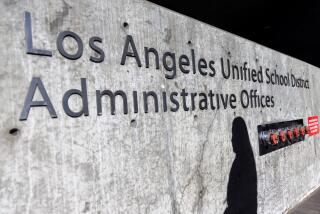1,500 Students Take Pledge to Avoid Drugs, Gangs
- Share via
More than 1,500 harbor-area fourth-graders stood shoulder-to-shoulder at the Los Angeles Harbor College football stadium in Wilmington on Thursday to form a human sign spelling out the word “NEVER” to express their sentiments about joining gangs and taking drugs.
The students, from 15 elementary schools throughout the South Bay, are recent graduates of an awareness program where they learned the dangers of joining a gang. The program was developed by harbor-area residents 10 years ago and is funded by the city and local business such as Unocal.
Since the program’s inception, more than 30,000 children have completed the 12-week program and gang-related crime in the harbor area has dropped by 35%. Supporters of the course say the program has helped curb gang activity since it reaches children before they have made up their minds on whether to join one.
“[The program] has achieved results which are truly spectacular and perhaps realized nowhere else across the entire nation,” said Mitch Maricich, a retired Los Angeles Police Department officer who worked in the harbor area.
The harbor area had always been ranked in the top three gang crime areas in Los Angeles, Maricich said.
But over the last three years the area has moved down the list, which is based on the 18 areas served by the Los Angeles Police Department. In 1994, the area was ranked seventh, in 1995 it moved to ninth and a 1996 ranking places the area at 14th.
The course is taught at 24 elementary schools in the harbor area. The lessons begin with a pretest where the students are asked if they think joining a gang would be cool and whether they would be proud to be a gang member.
After the exam, students participate in discussions on gang history, behavior, attire and the consequences of joining a gang. They learn to set goals for themselves, participate in self-esteem exercises and take part in activities such as graffiti cleanups.
At the end of the course, the students take the exam again. Students who still believe that gangs are cool once the course is finished are appointed a counselor who works with the individual student and the child’s family.
“We’ve been around 10 years and the crime rate has dropped,” said program senior advisor Daisy Ybarra. “We’re hoping that in another 10 years we’ll be able to make this a crime-free, violence-free area.”
More to Read
Sign up for Essential California
The most important California stories and recommendations in your inbox every morning.
You may occasionally receive promotional content from the Los Angeles Times.












